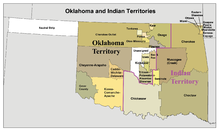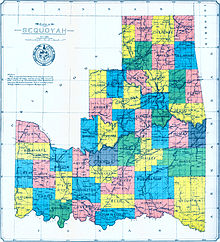Sequoyah (State)

Sequoyah was the name of a projected state in the United States on the area of what was then Indian territory in the eastern part of what is now Oklahoma . The project was ultimately not realized and the Territory of Sequoyah was instead united with the Oklahoma Territory to form the new state of Oklahoma in 1907 . The name was chosen in honor of Sequoyah , the inventor of the Cherokee script .
history
In 1890 , the Oklahoma Territory in the west was separated from the Indian Territory , which roughly included the area of what is now Oklahoma, and opened to white settlers ( Oklahoma Land Run ). The remaining Indian territory in the eastern part had a large Indian population from various tribes. However, both areas did not have state status. Since it was foreseeable that at some point the remaining Indian territory could also be lost to the Indians, a movement arose which sought to establish a separate Indian-influenced federal state within the framework of the Union on the soil of the Indian territory. In 1902 a meeting of delegates from the " Five Civilized Tribes " met for this purpose in Eufaula, Oklahoma . In 1903 there was another meeting to organize a constituent assembly for the newly founded state.
The constituent assembly
The Constituent Assembly met in Muskogee, Oklahoma on August 21, 1905. General Pleasant Porter , Chief of Muskogee (Creek) , was elected President of the congregation. Vice-presidents became the leaders or representatives of the five civilized nations: William C. Rogers , chief of the Cherokee ; William H. Murray , appointed by the Governor of the Chickasaw Douglas H. Johnston ; Chief Green McCurtain of the Choctaw ; Chief John Brown of the Seminoles and Charles N. Haskell as representative of the Muskogee (Creek) .
The assembly drafted a constitution, a plan for a government organization and the administrative division of the projected state, and elected delegates to apply to the United States Congress for admission as a state. The Assembly's proposals were adopted by an overwhelming majority in a referendum.
The failure of the project
The delegation was warmly received in Washington . Politicians from the eastern states in particular feared for their influence if two new western states, Oklahoma and Sequoyah, were admitted, and so President Theodore Roosevelt decided that the Indian and Oklahoma territories would only have a chance of admission as a federal state as a common state .
The representatives of the Indian Territory then united in the following year with the Constituent Assembly of the Oklahoma Territory in Guthrie and contributed their experience in drafting the new constitution for the entire state. On November 16, 1907, both territories were incorporated into the United States as the 46th state under the name Oklahoma.
Individual evidence
- ↑ The Choctaw . Museum of the Red River. 2005. Archived from the original on June 15, 2009. Info: The archive link was inserted automatically and has not yet been checked. Please check the original and archive link according to the instructions and then remove this notice. Retrieved April 18, 2008.
- ^ Oklahoma Historical Society: Sequoyah Convention
literature
- Bruce Elliott Johansen: The Encyclopedia of Native American legal tradition . Greenwood Publishing Group, 1998, ISBN 0-313-30167-0 , pp. 100-101 (English).

